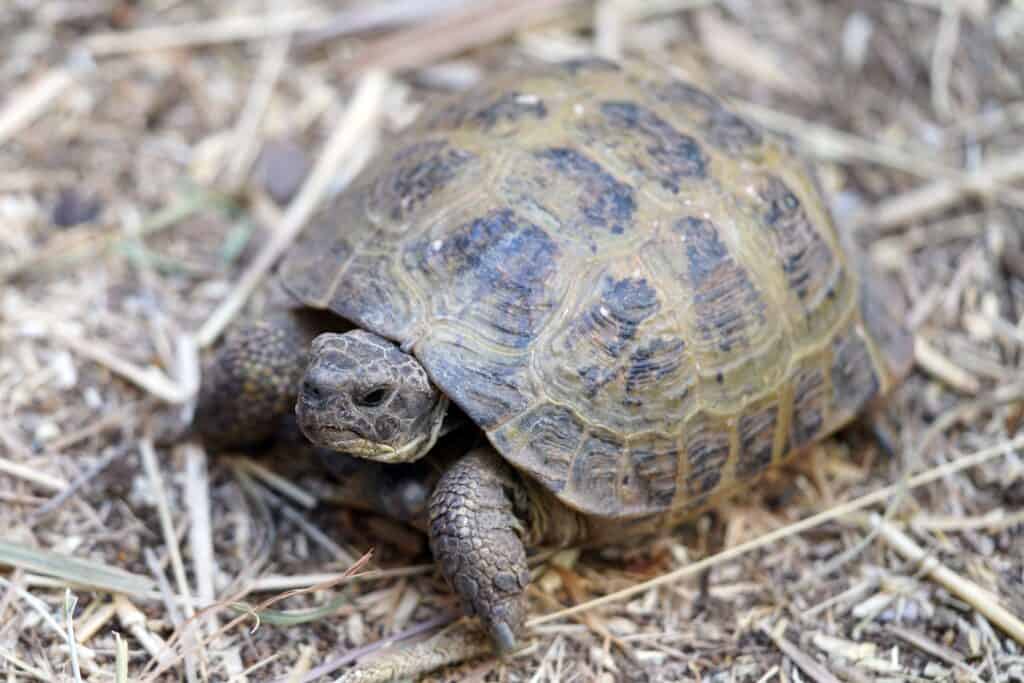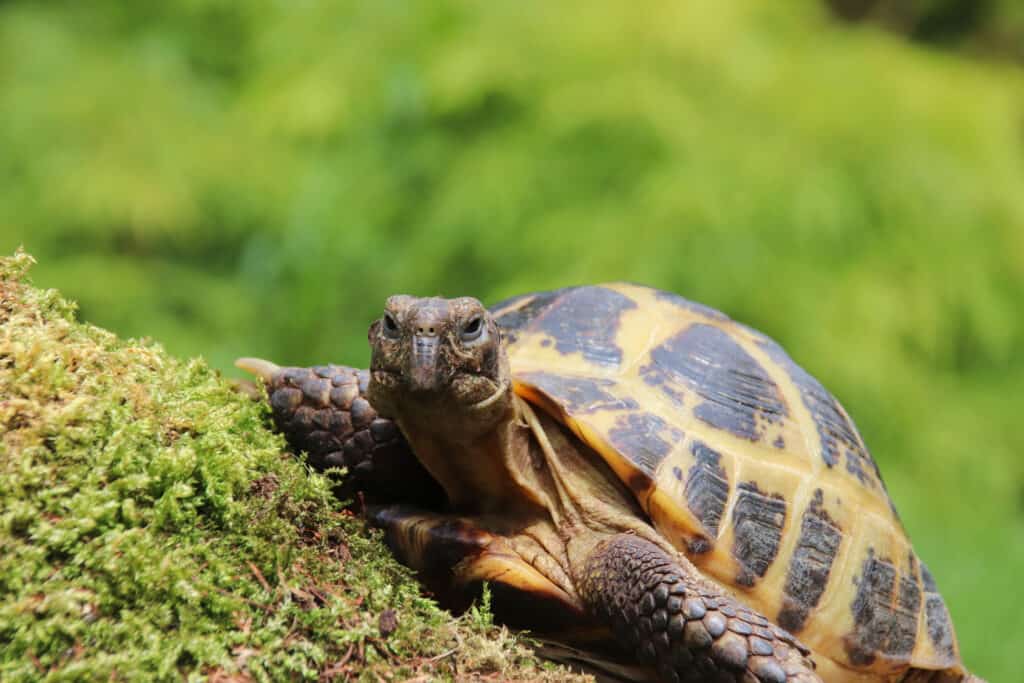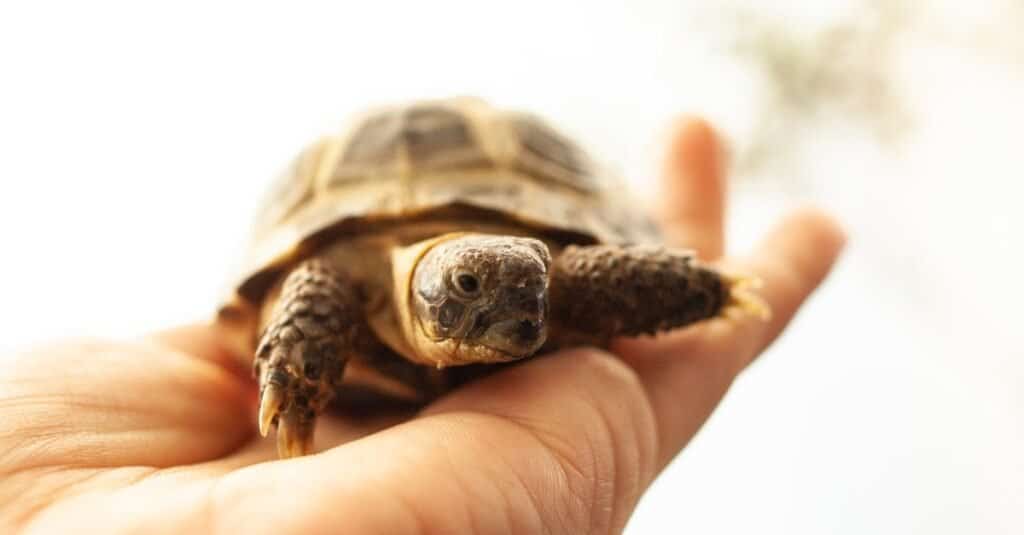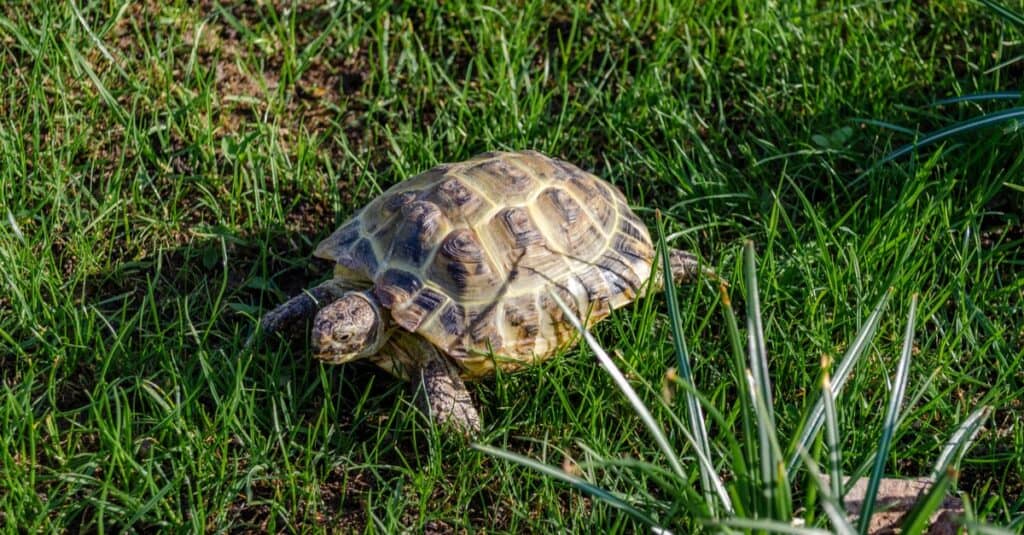Have you ever dreamed of having a tortoise as a pet? If so, the Russian tortoise might be just what you’re looking for! With small bodies and big personalities, they’ve earned their distinction as one of the most popular reptilian pets in the world. However, there are some important differences between males and females to be aware of before making a purchase. Compare the male vs female Russian tortoise to find out which one is right for you.
Comparing a Male vs Female Russian Tortoise

The Male Russian tortoise’s claws are longer and broader, which helps them hold onto the female during copulation.
©Karen Dole/Shutterstock.com
| Male Russian Tortoise | Female Russian Tortoise | |
|---|---|---|
| Size | Length: 5-8 inches Weight: 0.5 to 2.5 pounds | Length: 6-10 inches Weight: 0.5 to 2.5 pounds |
| Appearance | Smaller carapace with concave plastron; large claws; long, thin tails; long, pointed snout; cloaca between the middle and the end of the tail | Larger carapace with flat plastron; small claws; short, thick tails; short, rounded snout; cloaca near the base of the tail |
| Colour | Brown, tan, green, or olive with brown or black patches; dark underside | Brown, tan, green, or olive with brown or black patches; dark underside |
| Reproduction | Initiates mating, fertilizes female | Lays 2-6 eggs, may lay several clutches in one season |
| Behavior | Semi-social, very territorial | Semi-social, territorial |
The Key Differences Between a Male and a Female Russian Tortoise
The key differences between male and female Russian tortoises include size, appearance, color, reproduction, and behavior.
Male vs Female Russian Tortoise: Size

Female Russian tortoises are typically larger than males, reaching 6-10 inches in length.
©Susan Schmitz/Shutterstock.com
In Russian tortoises, males and females differ in size, though in this case, it’s the female who is larger. This is likely because her body needs to accommodate eggs. Female Russian tortoises can grow up to 6-10 inches in length, while males usually only reach 5-8 inches. These tortoises weigh between 0.5 to 2.5 pounds, though females are usually at the top end of that range, with males near the bottom.
Male vs Female Russian Tortoise: Appearance

Russian tortoises’ shells are brown to tan to green to olive in color with dark markings.
©Elena M. Tarasova/Shutterstock.com
Among tortoises, Russian tortoises are fairly small and stocky. The carapace, or upper part of the shell, is oval-shaped and rounded, and females’ carapaces will generally be larger than those of males. The plastron, or the underside of the shell, is slightly concave in males, allowing them to mount females more easily. In females, the flatter plastron gives them more space to carry eggs.
Both females and males have claws, but here the male wins out in terms of size. Male claws are longer and broader, which helps the male hold onto the female during copulation. Male Russian tortoises also have longer and thinner tails than females, allowing females to accommodate males more easily while mating. The tip of the tail in both sexes is bony.
There are two other ways to determine if a Russian tortoise is male or female. In males, the snout is typically longer and pointier than in females. At the other end of the body, the cloaca is positioned differently. A cloaca is a posterior orifice opening into a common tract for digestion, reproduction, and urination. The male cloaca lies between the middle and the end of the tail, while the female cloaca lies nearer the base of the tail.
These differences are next to impossible to see in juvenile Russian tortoises. As the tortoises mature, sex becomes easier.
Male vs Female Russian Tortoise: Colour

The skin of a Russian tortoise is greenish-yellow in color.
©Haoss/Shutterstock.com
Russian tortoise males and females appear similar in color. The carapace may be any color from brown to tan to green to olive, though some individuals will be bright yellow or nearly black. Dark markings are usually present on the carapace. The plastron is brownish with dark brown or black markings. The skin of a Russian tortoise is greenish-yellow in color.
Male vs Female Russian Tortoise: Reproduction

Russian tortoises lay 2-6 eggs at a time. New hatchlings are between 1.25 to 1.33 inches long.
©KOTORICHIKAPHOTO/Shutterstock.com
Russian tortoise mating usually happens in the spring after hibernation, though it can occur at any time of year. The male Russian tortoise is the one to initiate the mating encounter. As soon as he comes out of hibernation, he seeks a mate. When he finds an appropriate female, he circles her several times and then stops to face her. He bobs his head up and down while staring her in the face. He may bite or butt her, sometimes even removing scales from her front legs.
After copulation, the female will lay a clutch of 2-6 eggs, and she may lay eggs even if they aren’t fertilized. It is not unusual for a Russian tortoise female to lay 2-3 clutches after the initial one in the same season. An incubation period of 80-110 days in the wild is typical; in captivity, that number drops to 60-75 days.
Newly hatched Russian tortoises are between 1.25 to 1.33 inches long. They reach sexual maturity by the age of 10 years, though they don’t reach their full size until 20-30 years of age.
Male vs Female Russian Tortoise: Behavior

Russian tortoises are solitary and territorial, though they have spurts of social activity.
©Alexandra Kovaleva/Shutterstock.com
Like many other types of tortoises, Russian tortoises are typically solitary, though they have spurts of social activity. They sometimes visit one another’s burrows and spend time together in the wild. Occasionally, several individuals will share a burrow for the night.
However, this doesn’t mean that they enjoy doing this regularly. Russian tortoises can be very territorial, especially males. Fights over resources and females may occur when males reside together in an enclosed environment. Experts recommend keeping males by themselves in captivity. They may get along with females, but this cohabitation usually results in fertilized eggs. Interestingly, females will lay eggs regardless of whether or not a male has fertilized them.
Male vs Female Russian Tortoise: Habitat

Russian tortoises prefer arid, desert-like areas with rocky terrain, often at high elevations.
©Haoss/Shutterstock.com
Russian tortoises go by several names: the Central Asian tortoise, the steppe tortoise, Horsfield’s tortoise, the Afghan tortoise, and the four-clawed tortoise. They inhabit several countries, including Russia, China, Iran, Pakistan, and Afghanistan. They prefer arid, desert-like areas with rocky terrain, often at high elevations. Too much moisture isn’t good for this species, so it has adapted to survive in dry conditions. It won’t even urinate if adequate water isn’t available. Humidity levels of less than 70% and preferably between 40-50% are best. Their ideal daytime temperature range is between 70 and 90 degrees Fahrenheit.
Russian tortoises make their homes in caves, on sandy or loamy earth. In winter, they hibernate in south-facing burrows with plenty of sunlight. In summer, they often estivate, spending much of their time lying in burrows where it’s cool and shady.
Male vs Female Russian Tortoise: Lifespan

Russian tortoises make affectionate, low-maintenance pets.
©Elena M. Tarasova/Shutterstock.com
Russian tortoises have an average lifespan of 40-50 years in captivity. However, some individuals have lived to be up to 100 years old. For this reason, having a Russian tortoise as a pet can be a lifetime commitment. Check out Jonathan, who made the Guinness Book of World Records as the oldest living tortoise.
Russian Tortoises as Pets

Russian tortoises can show affection toward their owners and don’t mind being handled.
©Kirill Skorobogatko/Shutterstock.com
Russian tortoises make great pets, even for a first-time pet owner. They can show affection toward their owners and don’t mind being handled. Tortoise enthusiasts adore them for their big personalities and ease of care. They can live happy and healthy lives with the right temperature, lighting, substrate, and food. However, be aware that these reptiles can live over 40 years in captivity; they may even outlive their owners. Anyone purchasing a Russian tortoise should be prepared for a long-term commitment.
Both males and females make equally good pets. However, females lay eggs periodically, which is a minor inconvenience for the owner. Should the eggs be fertilized, care must be taken to ensure the health of the hatchlings.
Whether male or female, Russian tortoises make affectionate, low-maintenance pets.
The photo featured at the top of this post is ©
Thank you for reading! Have some feedback for us? Contact the AZ Animals editorial team.







